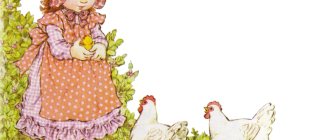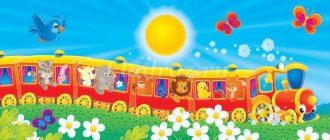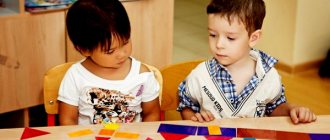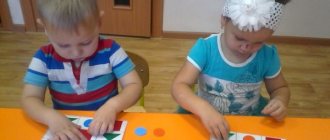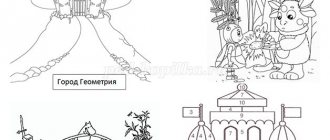Senior group. Senior preschool age. Children 5-6 years old
Summary of the lesson on FEMP for the senior group “Tasks of the Old Man-Borovitch” Topic: “Tasks of the Old Man-Borovitch”
Purpose of the lesson: 1. Practice quantitative and ordinal counting, spatial orientation and orientation on a sheet of paper. 2. Strengthen the ability to use tables. 3. Develop logical thinking, the ability to think and reason. 4….
Summary of a mathematics lesson in the senior group “Travel to the country of Mathematics. Counting within 10. Comparison by height" Summary of a mathematics lesson in the senior group . Topic: “Travel to the country of Mathematics ”
Goals: Developing interest in
mathematics , based on cognitive activity and curiosity. Objectives: • Improve mental counting skills within 10 in different directions • Continue…
Entertaining mathematics in pictures
Entertaining math material for preschool children.
All preschool children are real little explorers. They discover the whole world that surrounds them. Teachers and parents should work together to support the child in these explorations. They should try to maintain and develop the preschooler’s desire for knowledge and satisfy the desire for active activity, constantly fueling interest in the process of studying the world around him. Math games for preschoolers will be an excellent help with this.
The role and purposes of mathematical games
It is obvious that from birth a child needs to develop all his muscles. But they are not the only ones that require attention. The mind also needs constant training. After all, a person who is able to think logically easily copes with solving all life problems. He is able to make decisions faster, find a way out of difficult situations, and is more mobile and efficient.
The role of didactic games in the mathematical development of preschool children is great. It is through them that the knowledge of mathematics as a science and passion for it begins.
To develop logical thinking and mathematical abilities (and one is closely related to the other), it is necessary to use special games. This is the only way to instill an interest in mathematics.
The main goals of learning mathematics in the game for preschoolers:
· development of logical thinking;
· development of independence and the ability to solve problems without the help of adults;
· formation of interest in creative and cognitive activity;
· accumulation of logical and mathematical experience;
· familiarity with basic mathematical concepts from a very young preschool age;
· familiarity with basic operations: addition, subtraction, counting, etc.
Important!
You cannot stop using didactic games in middle and older preschool age. For the full development of mathematical abilities, it is necessary to train children year after year.
Types of tasks in mathematics
Preschool children are divided into three age groups:
junior (3-4 years), middle (4-5 years), senior (5-6 years). It happens that there is another group - preparatory - which includes children 6-7 years old. It is in accordance with the age category that it is necessary to select didactic games for young mathematicians.
Didactic activities are divided into the following:
· games;
· puzzles;
· joke tasks;
· puzzles;
· work with geometric material.
Important!
You should not play educational games in mathematics for too long. This is especially true for younger preschoolers. Initially, it is enough to conduct such exercises for 5 minutes a day.
DIY didactic games
To enhance the cognitive interest of students, teachers try to attract their attention in all possible ways. To achieve this goal, many parents and educators develop do-it-yourself math books for preschoolers. To make them, you can use any available material:
· fabric, threads, buttons;
· natural materials;
· stationery;
· imagination, it is given special importance in the creative process.
Examples include the following games:
· “Find the odd one out.” The game is played with the goal of analyzing geometric shapes, the ability to compare them and find what is superfluous. Children are asked to analyze rows of geometric shapes cut out of cardboard or other material and find the mistake in it. It may consist, for example, in finding a triangle among circles or distinguishing a figure from others by color.
· “Who are the neighbors.” This game requires only one additional item - a ball. With its help, the skill of naming neighbors of numbers is improved. Children stand in a circle, the teacher throws the ball and calls a random number. The child must catch the ball and name its neighbors.
· "Harvesting". The goal of this game is to develop the skill of comparing objects by size. Two baskets are placed in front of the children. You need to put large fruits and vegetables in one of them, and small ones in the second.
· Mathematical games for perception and memory training
· The most popular game is "Confusion". It is suitable for preschoolers of all age groups. Its meaning is as follows: cards with numbers from 1 to 9 are laid out on the table in random order. The child must arrange them in ascending or, conversely, descending order. For the little ones, you can use two or three numbers, gradually increasing the number of cards.
· “Clap your hands.” A very simple and interesting game. The teacher calls any number, and the child must clap his hands as many times as there are units in this number.
· "Do not snooze!". Cards with numbers are laid out on the table in front of the child, which are easy to make yourself. The teacher tells a fairy tale in which various numbers appear. As soon as any of them sounds, the children must quickly pick up the corresponding card.
Modern interactive tasks also play an important role in the development of mathematical abilities in preschool children through play activities. They must be selected taking into account the Federal State Educational Standard and correspond to the age category of the pupils.
Mathematical problems for ingenuity
Mathematical problems requiring ingenuity occupy a place of honor among all tasks. Children really like such exercises and develop a flexible, plastic mind and intelligence.
Examples:
· “There are 4 corners in the room, a cat sits in each corner, and opposite each cat there are 3 cats. How many cats are there in the room? (4 cats);
· “An animal has 2 right legs, 2 left legs, 2 legs in front, 2 in back. How many legs does he have? (total 4);
· “There were 7 brothers walking, each brother had one sister. How many people walked? (8 people);
· “7 boys cleared 1 path in the garden. How many paths did the boys clear?” (7 tracks).
Riddles, comic problems, entertaining questions
Such tasks, as a rule, arouse the greatest interest among children. This category includes both fun, simple tasks and didactic number composition games for preschoolers.
Examples:
· “Continue the phrase: if Sasha left the house before Seryozha, then Seryozha...” (left the house later than Sasha).
· “Guess the riddle in verse:
There's a puppy sitting on the porch
Warms his fluffy side.
The second one came running
And he sat down like a hero. How many puppies are there?
· “Grandma Dasha has a granddaughter Masha, a cat Fluff, and a dog Druzhok. How many grandchildren does grandma have?”
· The significance of such exercises: children are introduced to active mental activity and master the necessary counting skills. Thanks to such tasks, numeracy skills are developed quietly and in a light-hearted manner.
· Important!
All games and tasks must be selected taking into account the age group of the students. Young children will not be able to cope with difficult tasks, which can lead to a loss of interest in the subject and even a decrease in self-esteem.
· Older people, on the contrary, will not want to think about tasks that are too easy. They will simply not be interested in them. As a result, there may be a misconception about mathematics - children will consider it too difficult, older children - easy.
· All types of didactic games in mathematics contribute to the development of interest in numbers, problems and counting in children, starting from a very early age. With mathematical and logical thinking skills, a child’s adaptation to school is much faster. In the process of studying, children learn to reason, analyze and generalize the information received.
Principles of training
When introducing mathematics to young children, it is important to follow several principles that allow you to correctly structure the learning process.
- Step by step. The child is just beginning to try himself in the new role of a student - it is useless to demand that he master all the material in its entirety. After each topic covered, there are lessons to consolidate and review previously covered material. The level of difficulty of the topic and exercises should also be justified.
- Complexity. Mathematics for children 5 years old includes not only the rules of counting, addition, subtraction, but also tasks on logic, the ability to navigate in space, knowledge of geometric shapes, etc.
- Positive reinforcement. Praise is important for kids. This way they have an incentive to solve the problem and rejoice at their first successes.
- Availability. Not all children master the material quickly. If a child has difficulty completing a math task, it is better to offer another exercise that he can handle.
- Subjectivity and visibility. Toddlers do not immediately begin to count “to themselves.” For a long time they need visual reinforcement.
- Unobtrusiveness. Any exercise is offered in the form of a game and is not mandatory. The main goal is to interest and explain. If a child is not interested, he will not perceive the information properly.
Training program
We propose to consider a mathematics teaching program developed for preschoolers. Classes are designed for a group of students. However, a parent who has decided to teach a child independently can also resort to this course, adapting outdoor games for one child. To do this, it is enough to show your imagination and, if possible, involve other family members in participating.
In the preparatory group of the kindergarten, according to the standards, 2 developmental classes are conducted per week lasting 35 and 20 minutes, for a total of 70 lessons per year. Like any other discipline, mathematics requires practice. Therefore, we have introduced an additional 10 lessons to better master particularly complex topics. The first and last five lessons are devoted to repetition of previously studied material (blocks 1, 14). The remaining classes are divided into blocks according to the topic.
Thematic lesson plan for the year
| Block | Topic or activity | Serial number of classes |
| 1 | Repetition of learned material. By the age of 5, a child should know and be able to: · count to 20 in forward order; · compare objects by length, width, height; · recognize a triangle, circle, square; · know the left, right hand; · navigate in space - “ close-far”, “low-high”. | 1-5 |
| 2 | Direct and reverse order of numbers from 1 to 20. We count any surrounding objects. | 6-8 |
| Outdoor game. Hide and seek will appeal to restless students. This way they will practice counting skills in direct order. Subsequently, you can offer the presenter a reverse counting order. | 9 | |
| Repetition | 10 | |
| 3 | Little, much. Counting sticks, soft toys, and buttons are suitable as equipment. | 11-13 |
| Outdoor game. | 14 | |
| Repetition | 15 | |
| 4 | More less. Methodists recommend associating this sign with the crocodile, and the numbers with its food. It will open its mouth towards the larger plate. | 16-19 |
| Repetition | 20 | |
| 5 | Driving directions. Students already know their left and right hands. Teaching them to navigate in space with the help of direct questions and commands is not difficult. “Raise your left leg”, “close your right ear”, “take the hand of the neighbor on the right”, “how many cars are at the gate on the left?” | 21-24 |
| Outdoor game. A good option is to search for treasures using a drawn map with signs “Left” and “Right”, “Forward”, “Back”. | 25 | |
| 6 | Figures in geometry. | 26-30 |
| Repetition | 31 | |
| 7 | Verbal counting from a given number. One of the kids' favorite exercises to reinforce this topic is putting jumbled numbers in order. At this stage, you can try to expand the familiar volume of numbers from 20 to 30. | 32-36 |
| Outdoor game. For example, stick numbers on the children's clothes and have them stand in order while music plays. Those who do not have time to take their place are stolen by the wolf. The rest will exchange stickers, then repeat the exercise. | 37 | |
| Repetition | 38 | |
| 8 | Ordinal and cardinal numbers. Looking at several identical objects, students answer the question “how many?” Looking at several objects of different colors, they answer the question “Which one is red?” | 39-40 |
| Repetition | 41-42 | |
| 9 | Even Odd. Different sides of the street come to the rescue of parents and educators. During a walk or excursion, draw your child’s attention to the serial numbers of houses. | 43-46 |
| Outdoor game. | 47 | |
| Repetition | 48 | |
| 10 | Counting in fives. The child is interested in understanding how the minutes on the clock are grouped and why, when counting ten divisions, we say “2 o’clock.” | 49-54 |
| Repetition | 55 | |
| 11 | Group account. Involves counting objects in separate groups and counting the number of groups. For example, three apples in two baskets. | 56-60 |
| Outdoor game | 61 | |
| Repetition | 62 | |
| 12 | Solving simple addition and subtraction problems. The tasks are illustrated with pictures and toys. For example, there were 5 cars in the garage, and the driver took the children to kindergarten in one. How many cars are left in the garage? | 63-67 |
| Repetition | 68-70 | |
| 13 | Dividing a whole number into parts. | 71-75 |
| 14 | Repetition | 76-80 |
Tasks and exercises by age
Here are some examples of age-appropriate exercises . By analogy, the reader can easily create his own game tasks for completing the training program.
A 5 year old child will be interested in the following activities.
- Numbers are drawn on the sheet. Using the sample, the child traces them with certain colors.
- You can learn addition on sticks. So, to solve the example 3+2, the student will first lay out three sticks, then add two more, carefully recalculate the total number and give the answer.
- Towards the end of the training course, you can try to conduct a graphic dictation. It requires preliminary preparation. A simple drawing in cells is depicted on a notebook sheet. Students will duplicate it under dictation: “2 cells down, 4 cells to the right.” Despite its complexity, the exercise delights preschoolers.
